
Nantwich is a market town and civil parish in the unitary authority of Cheshire East in Cheshire, England. It has among the highest concentrations of listed buildings in England, with notably good examples of Tudor and Georgian architecture. It had a population of 14,045 in 2021.

Acton is a small village and former civil parish, now in the parish of Burland and Acton, lying immediately west of the town of Nantwich, in the unitary authority area of Cheshire East and the ceremonial county of Cheshire, England. The civil parish covered 762 acres (3.08 km2) and also included the small settlement of Dorfold and part of Burford, with an estimated population of 340 in 2006. It is administered jointly with the adjacent civil parishes of Henhull and Edleston. Historically, Acton refers to a township and also to an ancient parish in the Nantwich Hundred covering a wide area to the west of Nantwich. The area is agricultural, with dairy farming the main industry. Around a third of the area falls within the Dorfold Estate. Historically, agriculture was the major employer, but it has now been overtaken by the service industries, with many residents commuting significant distances outside the parish to work.

Nantwich is a market town and civil parish in Cheshire East, Cheshire, England. It contains 132 listed buildings and structures, with three classified as grade I, seven as grade II* and 122 as grade II. In the United Kingdom, the term "listed building" refers to a building or other structure officially designated as being of special architectural, historical or cultural significance. There are three grades: grade I denotes buildings of outstanding architectural or historical interest, grade II* denotes particularly significant buildings of more than local interest, and grade II includes buildings of special architectural or historical interest. Buildings in England are listed by the Secretary of State for Culture, Olympics, Media and Sport on recommendations provided by English Heritage, which also determines the grading. This list includes the listed buildings and structures within the boundaries of the civil parish of Nantwich.
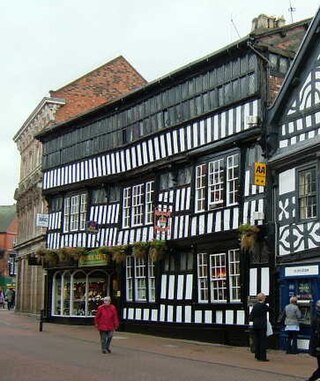
The Crown Hotel, also known as the Crown Inn, is a timber-framed, black-and-white hotel and public house located at 24 High Street in the town of Nantwich in Cheshire, England. The present building dates from shortly after 1583. One of three buildings in Nantwich to be listed at grade I, the listing describes the Crown Hotel as "an important late C16 building."

Nantwich Grammar School, later known as Nantwich and Acton Grammar School, is a former grammar school for girls and boys in Nantwich, Cheshire, England. It now forms part of the mixed comprehensive school, Malbank School and Sixth Form College.
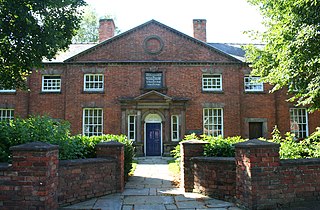
Crewe Almshouses or Crewe's Almshouses is a terrace of seven former almshouses at the end of Beam Street in Nantwich, Cheshire, England. The present building was erected in 1767 by John Crewe, later first Baron Crewe, and is listed at grade II. It has a central projecting section topped by a pediment, with a stone doorway flanked with Tuscan columns. The present almshouses stand on the site of a 16th-century building, originally the mansion of the Mainwaring family and later the town's House of Correction and workhouse.

The Primitive Methodist Chapel is a former Primitive Methodist church on Welsh Row in Nantwich, Cheshire, England. Built in 1840, it is listed at grade II. The chapel closed in 2001, and the building has been partially converted to residential use.

The Wesleyan Methodist Church, also known as the Wesleyan Chapel, is a former Wesleyan Methodist church on Hospital Street, Nantwich, Cheshire, England. Built in 1808, a new façade was added in 1876. The church then seated over a thousand, and was the largest Nonconformist place of worship in the town in the 1880s. It is listed at grade II. The church closed in 2009, after the congregation moved to the former Methodist schoolrooms opposite.

The Hospital of St Nicholas was a medieval hospital for travellers, which gave its name to Hospital Street in the English town of Nantwich in Cheshire. Founded in 1083–84 by William Malbank, first baron of Nantwich, it was dissolved in 1548 and probably later demolished.

39 Welsh Row is a Victorian former savings bank, in Jacobean Revival style, in Nantwich, Cheshire, England. It stands on the south side of Welsh Row at the junction with St Anne's Lane. Dating from 1846, it is listed at grade II. Nikolaus Pevsner describes number 39 as "the first noteworthy building" on Welsh Row, which he considers "the best street of Nantwich". The street has many listed buildings and is known for its mixture of architectural styles, including timber-framed black-and-white cottages such as the Wilbraham's and Widows' Almshouses, Georgian town houses such as Townwell House and number 83, and Victorian buildings such as the former Grammar School, Primitive Methodist Chapel and Tollemache Almshouses.

The Tollemache Almshouses, also known as the Wilbraham Almshouses or Wilbraham's Almshouses, are six former almshouses in Nantwich, Cheshire, England. They are in two blocks of three cottages each, located on the north side of Welsh Row at numbers 118–128. The present buildings, which are listed at grade II, were erected in 1870 by John Tollemache to replace adjacent almshouses founded by Sir Roger Wilbraham in 1613. The almshouses were modernised in 1980 and remain in residential use. The Hospital of St Lawrence, a medieval house for lepers, was possibly on or near the site of the present almshouses.

The Hospital of St Lawrence, variously known as St Lawrence's Hospital, the Hospice of St Lawrence and the free Chapel and Hospice of St Lawrence and St James, was a medieval house for lepers outside the town of Nantwich, Cheshire, England. It was located to the west of the town, on what is now Welsh Row, within the parish of Acton. St Lawrence's later became a hospital for the infirm poor. Dissolved in 1548, the hospital's land and property was purchased by the Wright family. One of its buildings was subsequently used for dwellings.

The Wilbraham's Almshouses, also known as the Wilbraham Almshouses, are six former almshouses in Nantwich, Cheshire, England, located on the north side of Welsh Row at numbers 112–116. Founded by Sir Roger Wilbraham in 1613, they were the town's earliest almshouses. They remained in use as almshouses until 1870, when they were replaced by the adjacent Tollemache Almshouses. The timber-framed building, which is listed at grade II, was subsequently used as a malthouse and as cottages, and was later considerably altered to form a single house. The Hospital of St Lawrence, a medieval house for lepers, might have been situated nearby.

Sir Roger Wilbraham was a prominent English lawyer who served as Solicitor-General for Ireland under Elizabeth I and was judged one of her few really competent Law Officers. He held a number of positions at court under James I, including Master of Requests and surveyor of the Court of Wards and Liveries. He bought an estate at Dorfold in the parish of Acton, near his birthplace of Nantwich in Cheshire, and he was active in charitable works locally, including founding two sets of almshouses for impoverished men. He also founded almshouses in Monken Hadley, Middlesex, where he is buried.
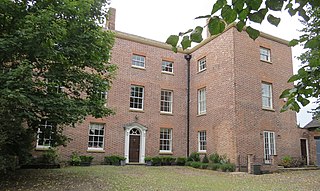
The Porch House, formerly sometimes the Porche House, is a large Georgian house, dating from the late 18th century, in Nantwich, Cheshire, England. It is listed at grade II. Located at numbers 64A and 64B on the north side of Welsh Row, it is entered via its former stable entrance, The Gateway. Currently divided into two houses, the Porch House has previously served as a day and boarding school, and as a house for Belgian refugees. The existing building stands on the site of a 15th-century mansion of the same name.

The Widows' Almshouses, also known as the Wilbraham or Wilbraham's Almshouses and as the Widows' Hospital, are former almshouses for six widows in Nantwich, Cheshire, England. They are located at numbers 26–30 on the north side of Welsh Row, on the junction with Second Wood Street. The almshouses were founded by Roger Wilbraham in 1676–7 in memory of his deceased wife in three existing cottages built in 1637; they were the earliest almshouses in the town for women. In 1705, Wilbraham also founded the Old Maids' Almshouse for two old maids in a separate building on Welsh Row. They remained in use as almshouses until the 1930s. The timber-framed Widows' Almshouses building, which is listed at grade II, has subsequently been used as a café, public house, night club, restaurant, wine bar and hotel.
Nantwich Castle was a Norman castle in Nantwich, Cheshire, England, built before 1180 to guard a ford across the River Weaver. The castle is first documented in 1288. It was last recorded in 1462, and was in ruins by 1485. No trace now remains above ground; excavations in 1978 near the Crown Inn uncovered terracing and two ditches, one or both of which possibly formed the castle's bailey.
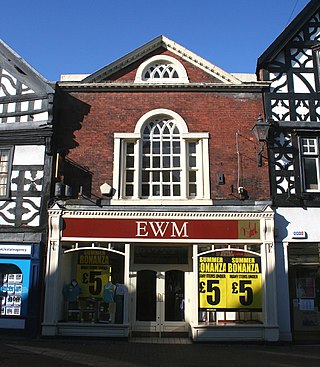
20 High Street is a grade-II-listed Georgian building in Nantwich, Cheshire, England, which dates from the late 18th century. It stands on the west side of the High Street. In the 18th century, the building was used as an inn and a venue for cock-fighting; it later became a private house and subsequently a shop. The site is believed to have been near the town's Norman castle.

Sweetbriar Hall is a timber-framed, "black and white" mansion house in the town of Nantwich, Cheshire, England, at 65 and 67 Hospital Street. It has been designated by English Heritage as a Grade II listed building.
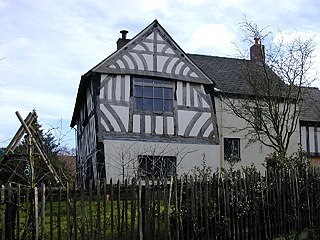
The Chantry House, also known as the Chantry Priests' (or Priest's) House and formerly the Old School House, is a medieval half-timbered or "black-and-white" house, dating from around 1527, in Bunbury, Cheshire, England. It was originally associated with the chantry chapel in the nearby parish church of St Boniface, founded by Sir Ralph Egerton. After the chantry's dissolution, it became associated with Thomas Aldersey's grammar school. The Chantry House is an early surviving example of a residential timber-framed building in Cheshire, with many typically medieval features. It is listed at grade II* for "the quality of framing throughout."


















